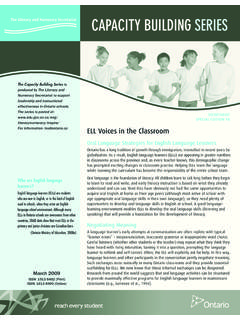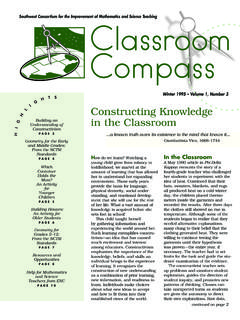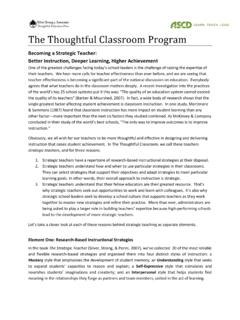Transcription of CLASSROOM CIRCLES Building Positive Relationships
1 CLASSROOM CIRCLES Building Positive Relationships Learning and teaching is a social experience. We can no longer separate curriculum from wellbeing . We are all wired to live and work in a social and emotional context. To really teach kids, we need to integrate what we know about our kids socially as well as developmentally, with how we help them to learn. We need to instill a love of learning. Young people nowadays will leave school with only a fraction of what they need to know to be successful citizens of the world, so to teach kids to be lovers of learning; we need to be lifelong learners as teachers. We will never teach them everything they need to know, so we need to teach them how to learn. For this to happen, we need to develop Positive Relationships with our school communities. To lay the foundations of a restorative school, we need to focus on a culture that embraces safe, collaborative Relationships shared philosophies, ideologies, values, assumptions, beliefs, expectations, attitudes and norms that knit our community together.
2 Relationships require some skills: Good listening listening involves understanding the meaning of what is being told. The importance of active listening; builds a bond between people Builds trust Helps people retell their stories Helps people to express their feelings Helps gather information Good communication the qualities of words, tone of voice and body language Our words count for 7% towards good communication Our tone of voice counts for 38% of good communication Our body language counts for 55% of good communication For our kids to feel safe in our classrooms, as their teachers, good communication is more about our body language and tone of voice that anything we say. Safety can be felt through someone s body language and tone of voice. The relationship between the adults in the school has more impact on the quality and character of a school than any other factor. Those Relationships are amplified throughout, and their reverberations determine the levels of motivation, conflict and learning that occur in a school.
3 Andrew Fuller Schools are not buildings, curriculum timetables and meetings. Schools are Relationships and interactions among people. Johns on & Johnson, 1994 Education is about Relationships , not control, and Relationships have inevitable conflict, which requires healing. Marist Youth Care The use of CIRCLES to build Positive Relationships and create collaborative and safe classrooms The circle format is an ancient form of communication for spiritual, political and communal life and is found throughout world traditions. It has been adapted for discussion and decision-making by teachers, social workers, judges, community members, police officers and students. The circle is used throughout the world when a group of people want to talk about an issue in a way that allows everyone to participate and contribute. It is a symbol of unity and cooperation. The Values of a circle Honesty, listening, accountability, spirituality, consensus, healing, patience, respect, support, trust, partnership and forgiveness Shared leadership, equality placing everyone in a circle minimizes structural distinctions between teacher and learner and sets a tone of equal participation and equal capacity to teach and learn among all participants.
4 Visual contact among all participants at all times in a circle no one is looking at anyone else s back. It is easier to listen and hear when there are direct sight and sound lines among participants Focus the structure of the circle focuses attention on the participants and task of the circle and reduces distractions. Connection the circle links all participants with one another encouraging a sense of shared effort or common purpose. Respect/accountability because everyone in a circle can see everyone else, disrespectful behavior such as side conversations or demeaning non-verbal actions are discouraged. If it happens it becomes obvious to everyone in the circle . Input and participation from all use of the technique of going around the circle providing each person with a chance to speak ensures that everyone has an opportunity to be heard and reduces domination of discussion by a small number of people. Inclusion in a circle no one feels isolated or left out.
5 A Talking Piece In order to facilitate and share speaking time in the circle , a talking piece is introduced. The desire to interrupt can be as strong as the desire to be heard without interruption. The talking piece can be almost any item. Indigenous Australians have used a talking stick for generations, so a stick signed by all classmates can make a favoured talking piece. Encourage participants to create their own talking piece, provided it is not too large, and has meaning that is connected to the ideals of community, - caring and peace. The guidelines that cover the use of the talking piece are It always moves clockwise around the circle , unless otherwise decided by the group. You do not talk when you do not have the talking piece You can pass the talking piece, you do not have to speak When you hold the talking piece, you must: Speak honestly and from the heart Speak with respect for others Try not to speak at length Speak to issues of the circle CIRCLES (sometimes referred to as circle time ) can be a structured, regular occasion when a class group meets in a circle to speak, listen, interact, enhance Relationships and share concerns.
6 Content is flexible and adaptable based on age and needs of the class. CIRCLES developed in classrooms build & enhance Relationships via knowledge and understanding of self and others, emotional literacy and interpersonal skills. The key elements of CIRCLES are: Having Positive Relationships with classmates Understanding and valuing oneself Understanding and valuing others When used regularly, and in a variety of ways, a circle helps young people to develop an appreciation of self, a sense of belonging, to have feelings of empathy with other members of the class, and to become empowered to use Positive problem solving behaviours. It indicates that a group is working together to support one another and to take responsibility for addressing issues. The circle process is a communication tool that can be used in a variety of ways. Community CIRCLES to teach pro-social skills and build Relationships this is commonly called circle time or a relational circle , designed to help students to get to know one another and connect to each other.
7 They usually involve the following activities: o Name games o Mixing-up activities Switch places those who like ice-cream. o Silent statements Switch places if you have a sister/enjoy sport. o Pass activities Smile/squeeze/high five o Sentence endings Something I am good at I am a good friend when .. I like it when someone o Use of Cards St Lukes Strength Cards/ Inyahead cards A celebration circle if someone has a birthday or special event (could be incorporated into the above) Dialogue/Discussion CIRCLES : Discussing and agreeing upon the common courtesies or norms of the group or CLASSROOM (Negotiating CLASSROOM rules, values, planning class excursions) Can also be used to discuss current events, moral dilemmas. Using political cartoons/complex issues delve into youth understandings. Prejudice - Pass talking piece around asking: What does that mean to you? What does it mean to this country? Describe a personal experience of feeling prejudice What can we do?
8 Problem Solving CIRCLES How do we feel? Who has been affected by this problem? How have they been affected? How can we solve the problem so it doesn t continue to be a problem? Reviewing curriculum How do we feel How can we make this topic more relevant? Who would like some support or buddy to work through these curriculum issues? Who is willing to be that buddy? A reflection or evaluation circle what did we learn today, or what do I already know (or from that session) A social skill circle many social skills programs can be effectively run in CIRCLES social skills like listening, friendships, kindness, respect, forgiveness, taking turns, cooperation. A restorative circle around a particular issue that has affected all classmates what happened, who was affected, what can we do to make it better? CLASSROOM CIRCLES CLASSROOM CIRCLES are a great way to allow students to develop and enhance life skills that are so important to all of us.
9 They take many forms, from getting to know one another, to curriculum topics, to cooperative activities to problem solving and conflict resolution. Everyone takes part in what becomes a democratic, participatory CLASSROOM with a focus on Relationships and responsibilities. Some of the outcomes of effective CLASSROOM CIRCLES are: When students feel respected and are included in a dignified process, they feel compelled to own their behaviour. In every one of us there is a deep desire to connect to others in a good way. CIRCLES assume a universal human wish to be connected to others in a good way. The Little Book of circle Processes When students participate in processes that are procedurally fair they begin to take responsibility for personal behaviour. When students are part of the solution they begin to develop empathy and insight. Students who participate in CLASSROOM CIRCLES learn about fairness and justice. Students when provided with a safe forum are able to talk about what was done to them and how it can be fixed.
10 RESOURCES Books: The Little Book of circle Processes Kay Pranis Available from Peacemaking CIRCLES From Crime to Community Pranis, Stuart & Wedge Calling the circle The First and Future Culture - Baldwin CLASSROOM Manuals with circle activities: Working in CIRCLES in Primary and Secondary Classrooms Marg Armstrong & Dave Vinegrad circle Time circle Time Resources Coming Around to circle Time circle Time for the Very Young circle Time in Secondary Schools Set of 3 booklets Six Years of circle Time circle Time for Adolescents circle Time and Learning about Feelings circle Time and Learning about Stories circle Time for Emotional Literacy- Sue Roffey The circle Time Games & Activities Book- Inyahead Press All available from Inyahead Press Ph 1300 556 830 Useful Cards used in CIRCLES : I Can Monsters Stones have Feelings Too Strength Cards for Kids Angels with Attitude Strength Cards Reflections The Bears Mates Traits Cars R Us Picture This All available from St Lukes Innovative Resources Ph: (03) 5442 0500 Straight Talk The Heartmasters Coping Cards The Heartmasters Resilience Cards Values & Attributes/ Feelings/Behaviours The Heartmasters Communication Cards The Heartmasters Thinking Cards All available from Inyahead Press Ph 1300 556 830 Prepared by: Marg Armstrong Just Practices PO Box 644, Mentone, 3194 Ph: 03 9589 6468 Mb: 0414 846439 Em: Wb The key to school improvement would be found, not in programs, not in structures, not in timetables, but in the quality of the Relationships Otero, 07






